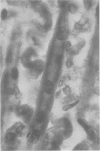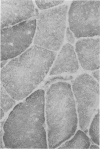Abstract
Clinical differences exist between the three forms of myotubular myopathy. They differ regarding age at onset, severity of the disease, and prognosis, and also regarding some of the clinical characteristics. The autosomal dominant form mostly has a later onset and milder course than the X linked form, and the autosomal recessive form is intermediate in both respects. These differences are, however, quantitative rather than qualitative. Muscle biopsy studies of family members are useful in some cases, and immunohistochemical staining of desmin and vimentin may help distinguish between the X linked and autosomal forms. Determining the mode of inheritance and prognosis in individual families, especially those with a single male patient, still poses a problem. Current molecular genetic results indicate that the gene for the X linked form is located in the proximal Xq28 region. Further molecular genetic studies are needed to examine the existence of genetic heterogeneity in myotubular myopathy and to facilitate diagnosis.
Full text
PDF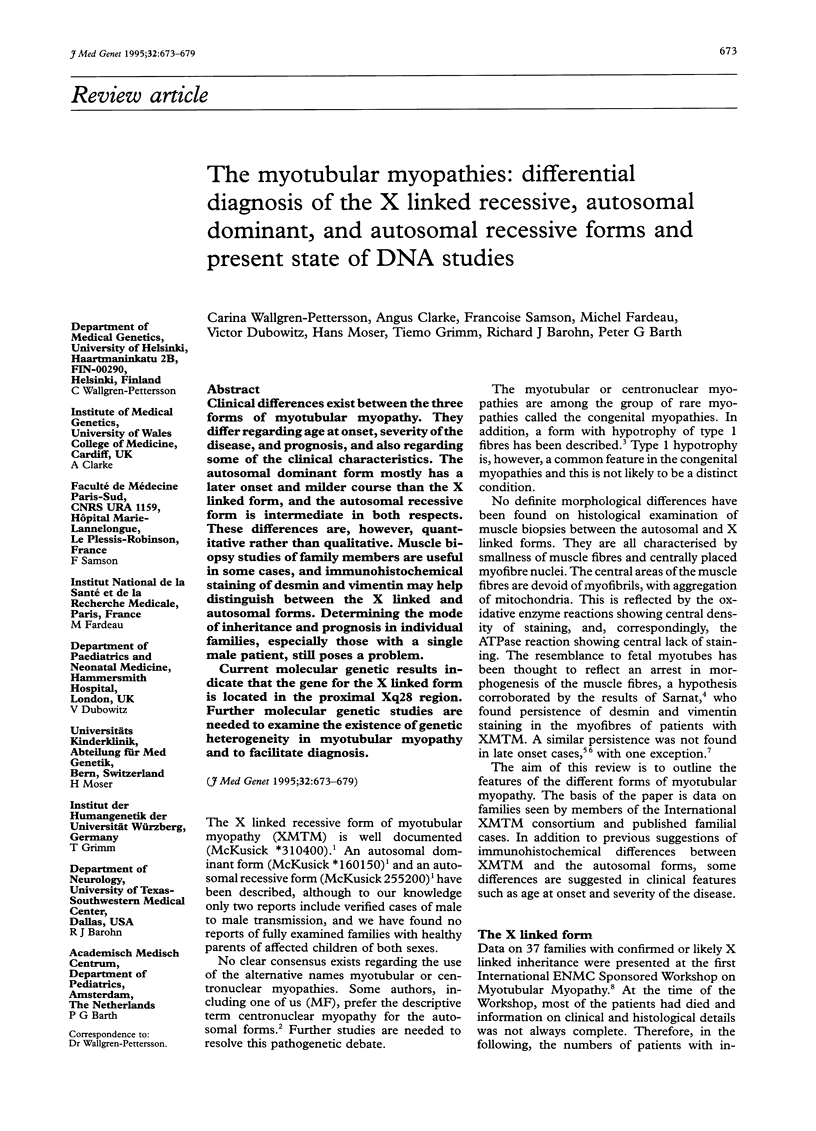
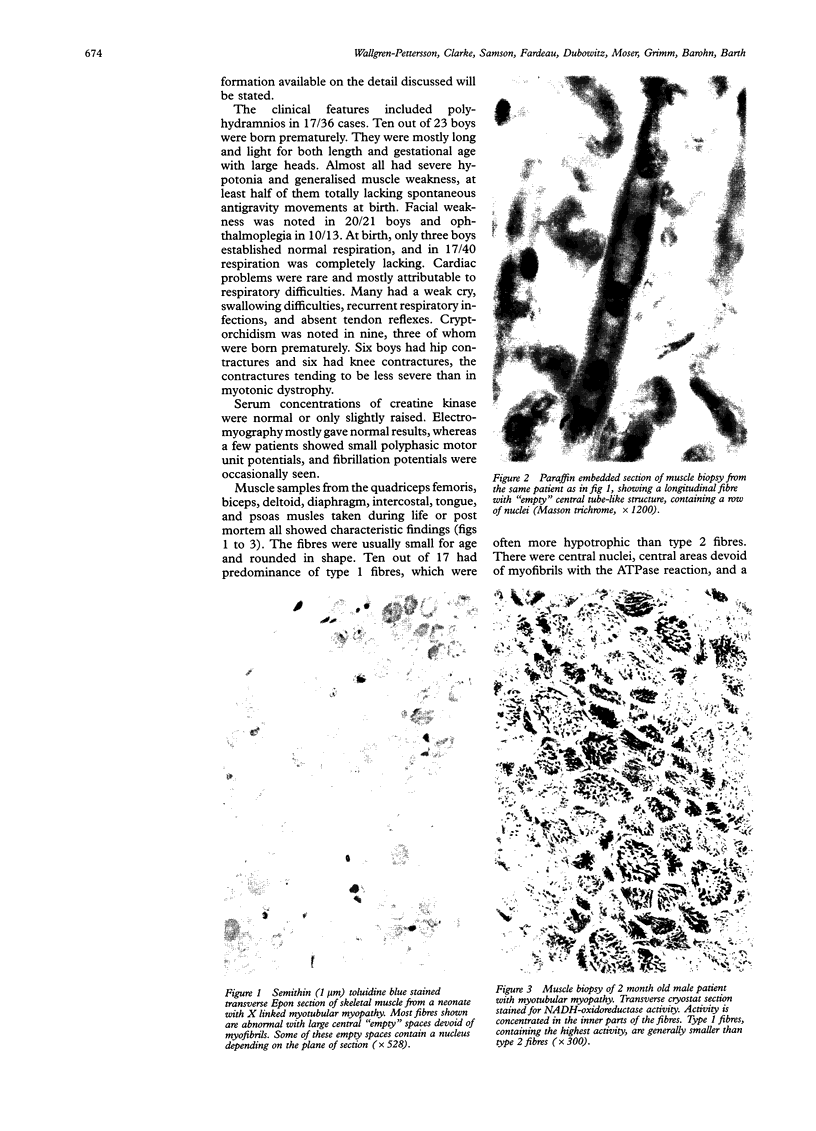
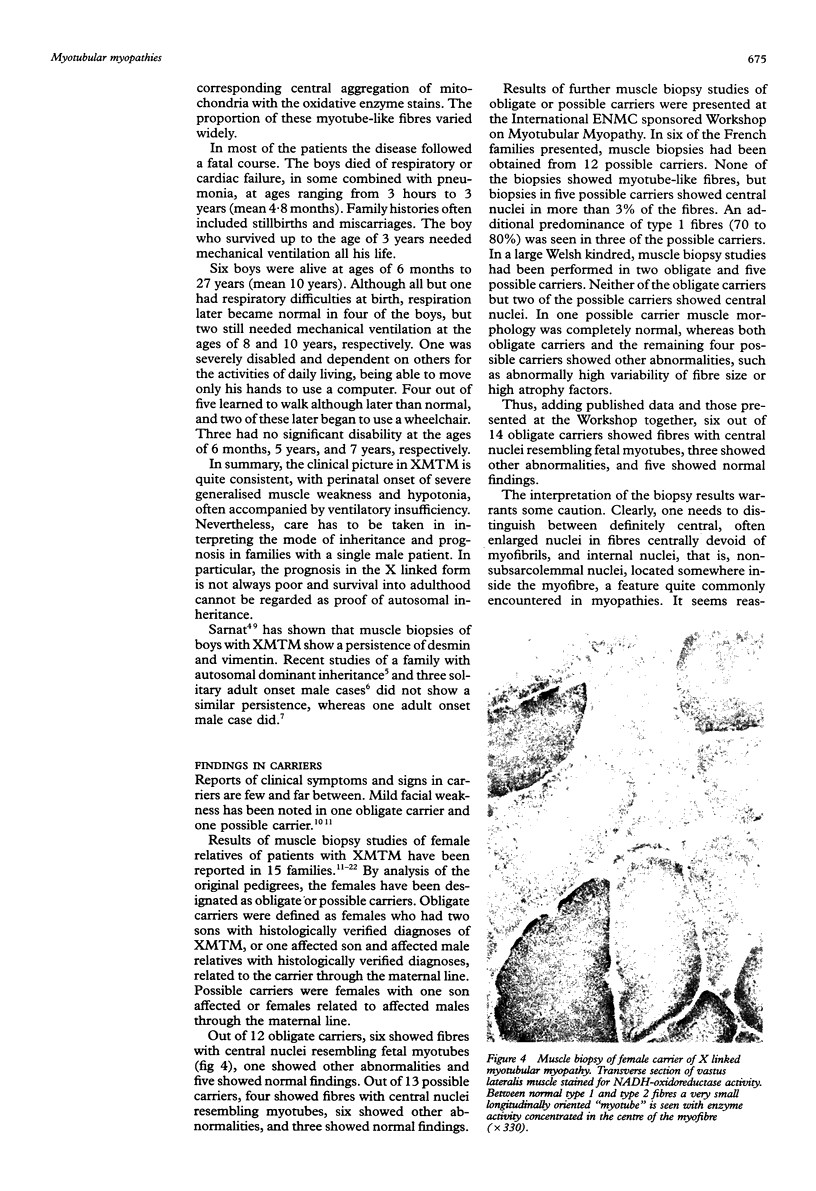
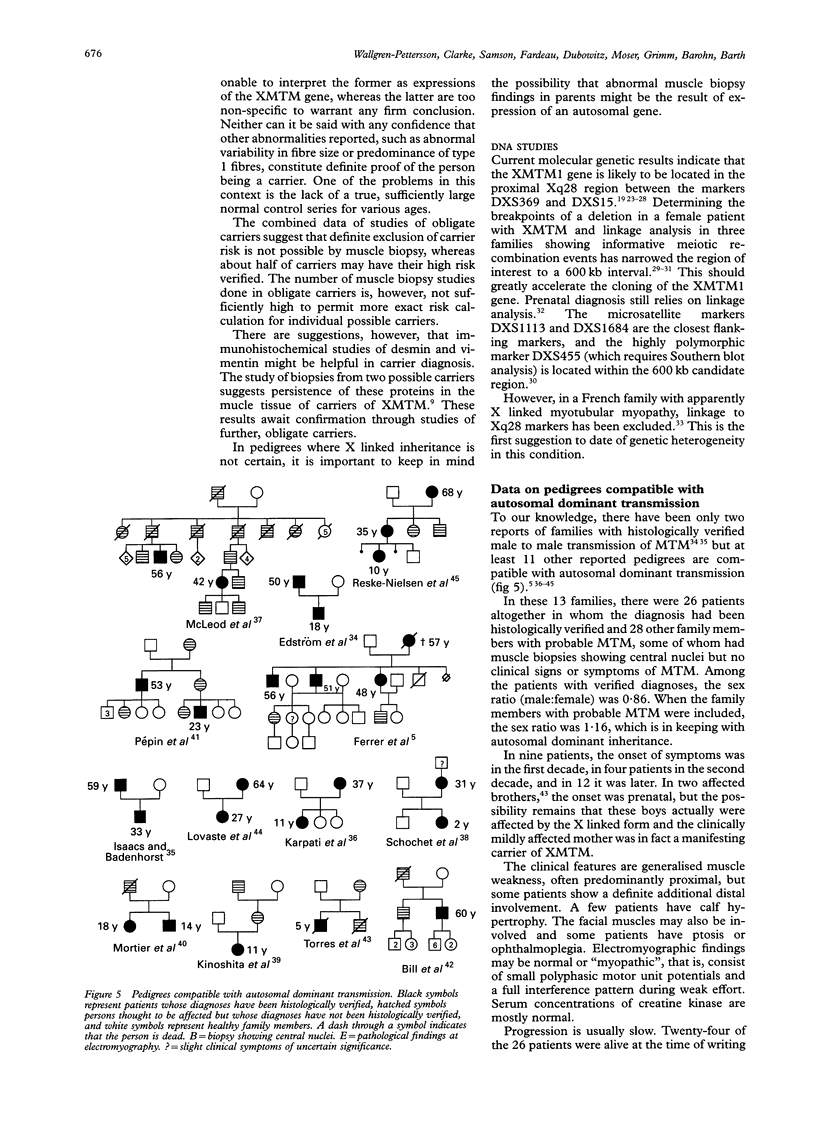
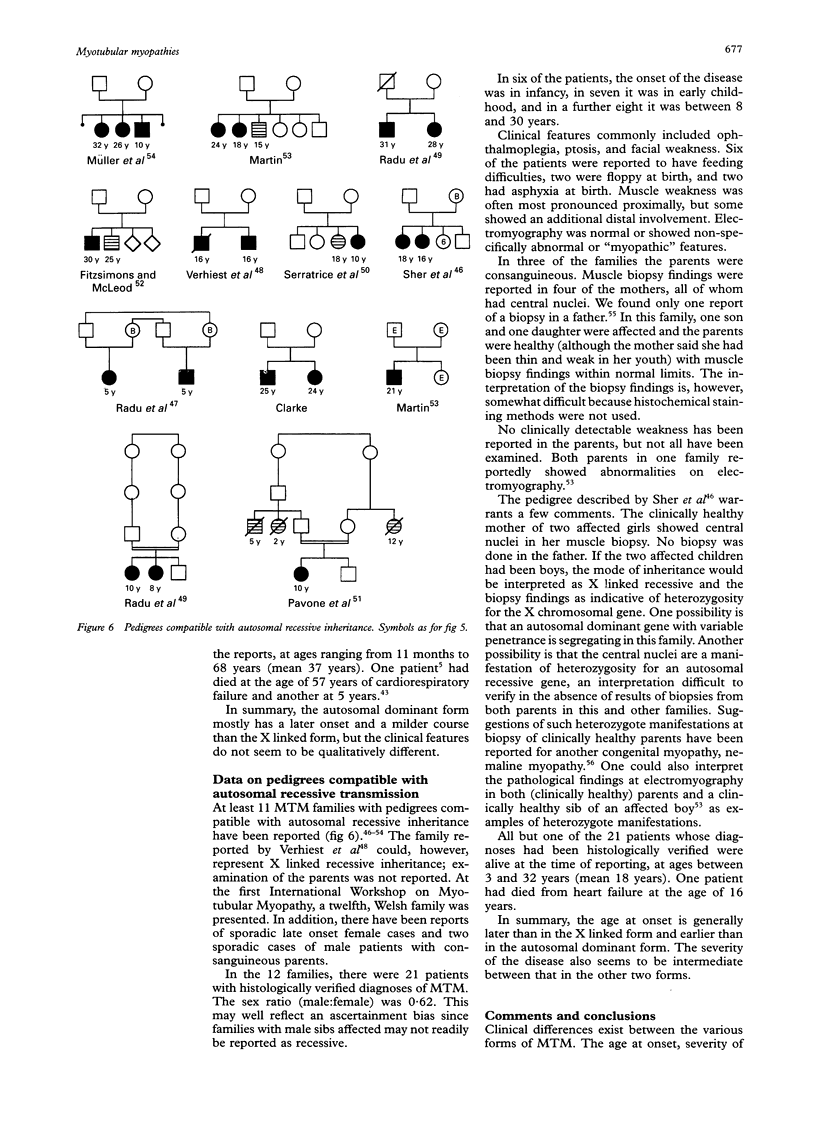
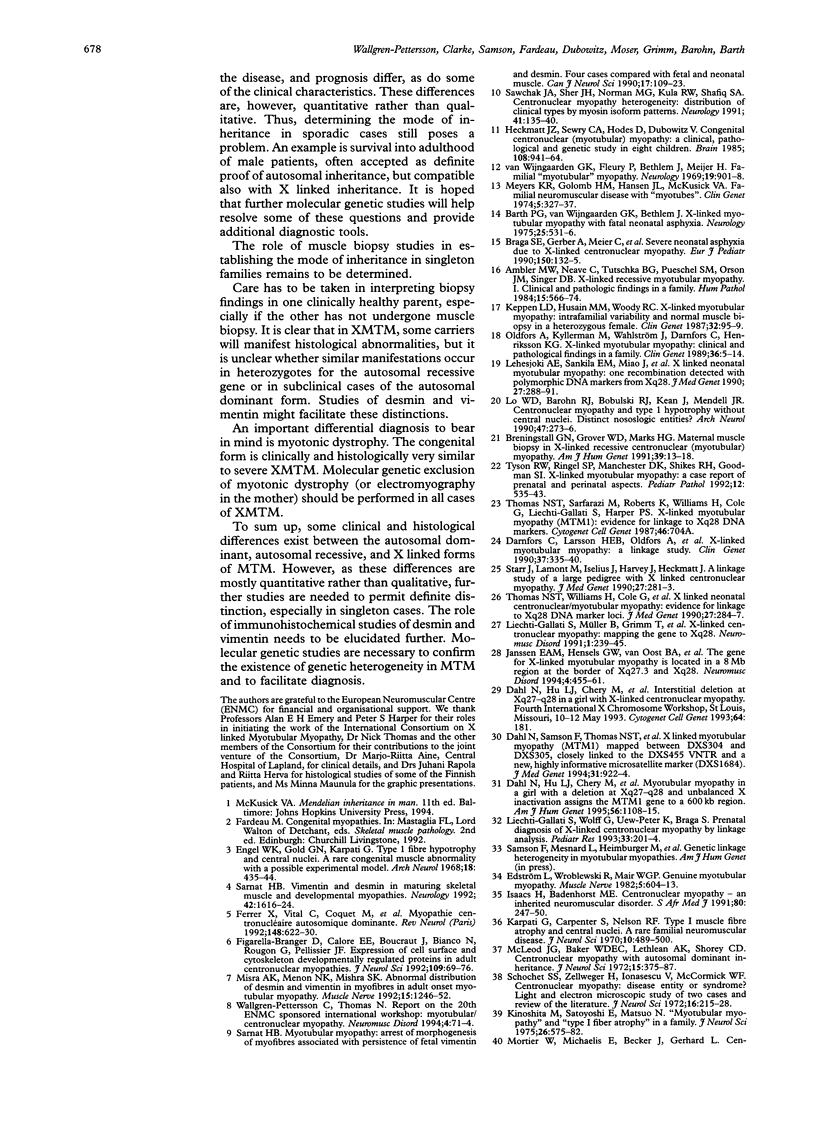
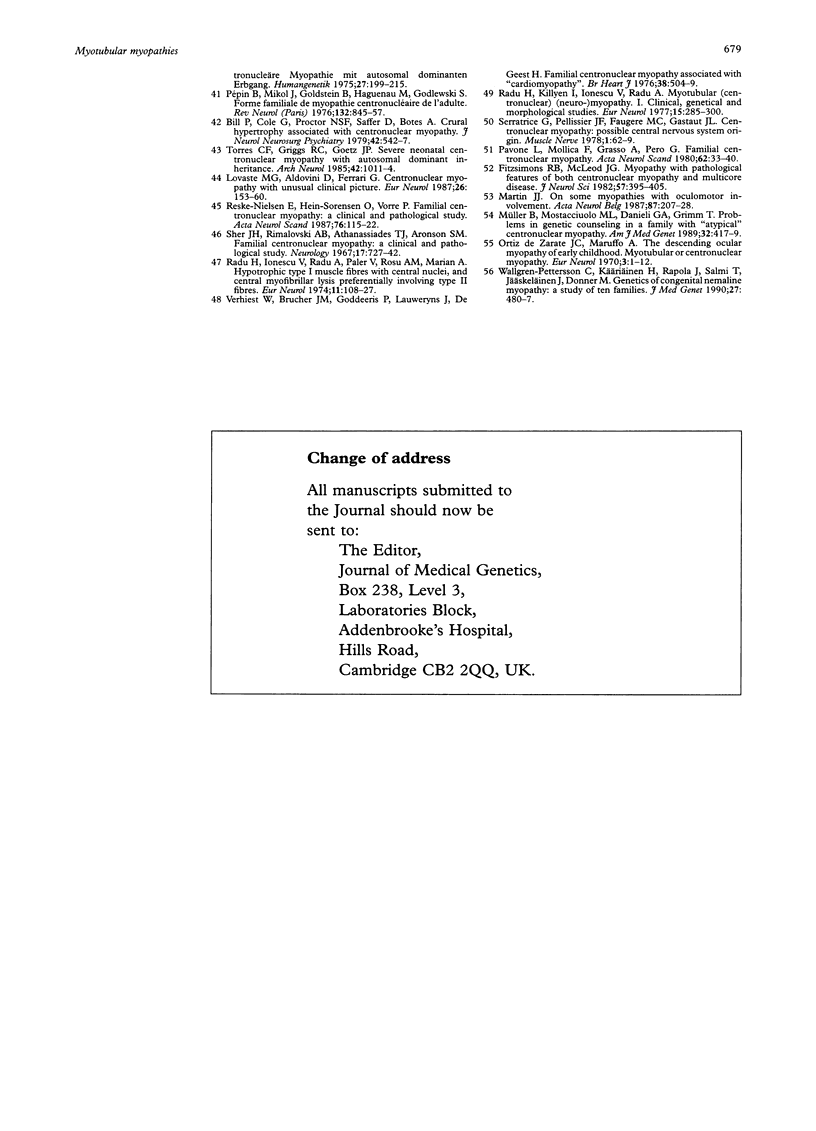
Images in this article
Selected References
These references are in PubMed. This may not be the complete list of references from this article.
- Ambler M. W., Neave C., Tutschka B. G., Pueschel S. M., Orson J. M., Singer D. B. X-linked recessive myotubular myopathy: I. Clinical and pathologic findings in a family. Hum Pathol. 1984 Jun;15(6):566–574. doi: 10.1016/s0046-8177(84)80011-8. [DOI] [PubMed] [Google Scholar]
- Barth P. G., Van Wijngaarden G. K., Bethlem J. X-linked myotubular myopathy with fatal neonatal asphyxia. Neurology. 1975 Jun;25(6):531–536. doi: 10.1212/wnl.25.6.531. [DOI] [PubMed] [Google Scholar]
- Bill P., Cole G., Proctor N. S., Saffer D., Botes A. Crural hypertrophy associated with centronuclear myopathy. J Neurol Neurosurg Psychiatry. 1979 Jun;42(6):542–547. doi: 10.1136/jnnp.42.6.542. [DOI] [PMC free article] [PubMed] [Google Scholar]
- Braga S. E., Gerber A., Meier C., Weiersmüller A., Zimmermann A., Herrmann U., Liechti S., Moser H. Severe neonatal asphyxia due to X-linked centronuclear myopathy. Eur J Pediatr. 1990 Dec;150(2):132–135. doi: 10.1007/BF02072056. [DOI] [PubMed] [Google Scholar]
- Breningstall G. N., Grover W. D., Marks H. G. Maternal muscle biopsy in X-linked recessive centronuclear (myotubular) myopathy. Am J Med Genet. 1991 Apr 1;39(1):13–18. doi: 10.1002/ajmg.1320390105. [DOI] [PubMed] [Google Scholar]
- Dahl N., Hu L. J., Chery M., Fardeau M., Gilgenkrantz S., Nivelon-Chevallier A., Sidaner-Noisette I., Mugneret F., Gouyon J. B., Gal A. Myotubular myopathy in a girl with a deletion at Xq27-q28 and unbalanced X inactivation assigns the MTM1 gene to a 600-kb region. Am J Hum Genet. 1995 May;56(5):1108–1115. [PMC free article] [PubMed] [Google Scholar]
- Dahl N., Samson F., Thomas N. S., Hu L. J., Gong W., Herman G., Laporte J., Kioschis P., Poustka A., Mandel J. L. X linked myotubular myopathy (MTM1) maps between DXS304 and DXS305, closely linked to the DXS455 VNTR and a new, highly informative microsatellite marker (DXS1684). J Med Genet. 1994 Dec;31(12):922–924. doi: 10.1136/jmg.31.12.922. [DOI] [PMC free article] [PubMed] [Google Scholar]
- Darnfors C., Larsson H. E., Oldfors A., Kyllerman M., Gustavson K. H., Bjursell G., Wahlström J. X-linked myotubular myopathy: a linkage study. Clin Genet. 1990 May;37(5):335–340. doi: 10.1111/j.1399-0004.1990.tb03515.x. [DOI] [PubMed] [Google Scholar]
- Edström L., Wróblewski R., Mair W. G. Genuine myotubular myopathy. Muscle Nerve. 1982 Oct;5(8):604–613. doi: 10.1002/mus.880050804. [DOI] [PubMed] [Google Scholar]
- Engel W. K., Gold G. N., Karpati G. Type I fiber hypotrophy and central nuclei. A rare congenital muscle abnormality with a possible experimental model. Arch Neurol. 1968 Apr;18(4):435–444. doi: 10.1001/archneur.1968.00470340121011. [DOI] [PubMed] [Google Scholar]
- Ferrer X., Vital C., Coquet M., Deleplanque B., Ellie E., Lagueny A., Julien J. Myopathie centronucléaire autosomique dominante. Rev Neurol (Paris) 1992;148(10):622–630. [PubMed] [Google Scholar]
- Figarella-Branger D., Calore E. E., Boucraut J., Bianco N., Rougon G., Pellissier J. F. Expression of cell surface and cytoskeleton developmentally regulated proteins in adult centronuclear myopathies. J Neurol Sci. 1992 May;109(1):69–76. doi: 10.1016/0022-510x(92)90096-4. [DOI] [PubMed] [Google Scholar]
- Fitzsimons R. B., McLeod J. G. Myopathy with pathological features of both centronuclear myopathy and multicore disease. J Neurol Sci. 1982 Dec;57(2-3):395–405. doi: 10.1016/0022-510x(82)90044-2. [DOI] [PubMed] [Google Scholar]
- Heckmatt J. Z., Sewry C. A., Hodes D., Dubowitz V. Congenital centronuclear (myotubular) myopathy. A clinical, pathological and genetic study in eight children. Brain. 1985 Dec;108(Pt 4):941–964. doi: 10.1093/brain/108.4.941. [DOI] [PubMed] [Google Scholar]
- Isaacs H., Badenhorst M. E. Centronuclear myopathy--an inherited neuromuscular disorder. A report of 3 cases. S Afr Med J. 1991 Sep 7;80(5):247–250. [PubMed] [Google Scholar]
- Janssen E. A., Hensels G. W., van Oost B. A., Hamel B. C., Kemp S., Baas F., Weber J. W., Barth P. G., Bolhuis P. A. The gene for X-linked myotubular myopathy is located in an 8 Mb region at the border of Xq27.3 and Xq28. Neuromuscul Disord. 1994 Sep-Nov;4(5-6):455–461. doi: 10.1016/0960-8966(94)90084-1. [DOI] [PubMed] [Google Scholar]
- Karpati G., Carpenter S., Nelson R. F. Type I muscle fibre atrophy and central nuclei. A rare familial neuromuscular disease. J Neurol Sci. 1970 May;10(5):489–500. doi: 10.1016/0022-510x(70)90027-4. [DOI] [PubMed] [Google Scholar]
- Keppen L. D., Husain M. M., Woody R. C. X-linked myotubular myopathy: intrafamilial variability and normal muscle biopsy in a heterozygous female. Clin Genet. 1987 Aug;32(2):95–99. doi: 10.1111/j.1399-0004.1987.tb03332.x. [DOI] [PubMed] [Google Scholar]
- Lehesjoki A. E., Sankila E. M., Miao J., Somer M., Salonen R., Rapola J., de la Chapelle A. X linked neonatal myotubular myopathy: one recombination detected with four polymorphic DNA markers from Xq28. J Med Genet. 1990 May;27(5):288–291. doi: 10.1136/jmg.27.5.288. [DOI] [PMC free article] [PubMed] [Google Scholar]
- Liechti-Gallati S., Müller B., Grimm T., Kress W., Müller C., Boltshauser E., Moser H., Braga S. X-linked centronuclear myopathy: mapping the gene to Xq28. Neuromuscul Disord. 1991;1(4):239–245. doi: 10.1016/0960-8966(91)90096-b. [DOI] [PubMed] [Google Scholar]
- Liechti-Gallati S., Wolff G., Ketelsen U. P., Braga S. Prenatal diagnosis of X-linked centronuclear myopathy by linkage analysis. Pediatr Res. 1993 Feb;33(2):201–204. doi: 10.1203/00006450-199302000-00022. [DOI] [PubMed] [Google Scholar]
- Lo W. D., Barohn R. J., Bobulski R. J., Kean J., Mendell J. R. Centronuclear myopathy and type-1 hypotrophy without central nuclei. Distinct nosologic entities? Arch Neurol. 1990 Mar;47(3):273–276. doi: 10.1001/archneur.1990.00530030039013. [DOI] [PubMed] [Google Scholar]
- Lovaste M. G., Aldovini D., Ferrari G. Centronuclear myopathy with unusual clinical picture. Eur Neurol. 1987;26(3):153–160. doi: 10.1159/000116328. [DOI] [PubMed] [Google Scholar]
- Martin J. J. On some myopathies with oculomotor involvement. Acta Neurol Belg. 1987 Aug-Oct;87(4):207–228. [PubMed] [Google Scholar]
- McLeod J. G., Baker W. de C., Lethlean A. K., Shorey C. D. Centronuclear myopathy with autosomal dominant inheritance. J Neurol Sci. 1972 Apr;15(4):375–387. doi: 10.1016/0022-510x(72)90166-9. [DOI] [PubMed] [Google Scholar]
- Meyers K. R., Golomb H. M., Hansen J. L., McKusick V. A. Familial neuromuscular disease with "myotubes". Clin Genet. 1974;5(4):327–337. doi: 10.1111/j.1399-0004.1974.tb01702.x. [DOI] [PubMed] [Google Scholar]
- Mortier W., Michaelis E., Becker J., Gerhard L. Cetronucleäre Myopathie mit autosomal dominantem Erbgang. Humangenetik. 1975;27(3):199–215. doi: 10.1007/BF00278346. [DOI] [PubMed] [Google Scholar]
- Müller B., Mostacciuolo M. L., Danieli G. A., Grimm T. Problems in genetic counseling in a family with an "atypical" centronuclear myopathy. Am J Med Genet. 1989 Mar;32(3):417–419. doi: 10.1002/ajmg.1320320330. [DOI] [PubMed] [Google Scholar]
- Oldfors A., Kyllerman M., Wahlström J., Darnfors C., Henriksson K. G. X-linked myotubular myopathy: clinical and pathological findings in a family. Clin Genet. 1989 Jul;36(1):5–14. doi: 10.1111/j.1399-0004.1989.tb03360.x. [DOI] [PubMed] [Google Scholar]
- Ortiz de Zarate J. C., Maruffo A. The descending ocular myopathy of early childhood; myotubular or centronuclear myopathy. Eur Neurol. 1970;3(1):1–12. doi: 10.1159/000113955. [DOI] [PubMed] [Google Scholar]
- Pavone L., Mollica F., Grasso A., Pero G. Familial centronuclear myopathy. Acta Neurol Scand. 1980 Jul;62(1):33–40. doi: 10.1111/j.1600-0404.1980.tb03001.x. [DOI] [PubMed] [Google Scholar]
- Pépin B., Mikol J., Goldstein B., Haguenau M., Godlewski S. Forme familiale de myopathie centronucléaire de l'adulte. Rev Neurol (Paris) 1976 Dec;132(12):845–857. [PubMed] [Google Scholar]
- Radu H., Ionescu V., Radu A., Paler V., Roşu A. M., Marian A. Hypotrophic type I muscle fibres with central nuclei, and central myofibrillar lysis preferentially involving type II fibres. Eur Neurol. 1974;11(2):108–127. doi: 10.1159/000114311. [DOI] [PubMed] [Google Scholar]
- Radu H., Killyen I., Ionescu V., Radu A. Myotubular (centronuclear) (neuro-)myopathy. I. Clinical, genetical and morphological studies. Eur Neurol. 1977;15(5):285–300. doi: 10.1159/000114815. [DOI] [PubMed] [Google Scholar]
- Reske-Nielsen E., Hein-Sørensen O., Vorre P. Familial centronuclear myopathy: a clinical and pathological study. Acta Neurol Scand. 1987 Aug;76(2):115–122. doi: 10.1111/j.1600-0404.1987.tb03554.x. [DOI] [PubMed] [Google Scholar]
- Sarnat H. B. Myotubular myopathy: arrest of morphogenesis of myofibres associated with persistence of fetal vimentin and desmin. Four cases compared with fetal and neonatal muscle. Can J Neurol Sci. 1990 May;17(2):109–123. doi: 10.1017/s0317167100030304. [DOI] [PubMed] [Google Scholar]
- Sarnat H. B. Vimentin and desmin in maturing skeletal muscle and developmental myopathies. Neurology. 1992 Aug;42(8):1616–1624. doi: 10.1212/wnl.42.8.1616. [DOI] [PubMed] [Google Scholar]
- Schochet S. S., Jr, Zellweger H., Ionasescu V., McCormick W. F. Centronuclear myopathy: disease entity or a syndrome? Light- and electron-microscopic study of two cases and review of the literature. J Neurol Sci. 1972 Jun;16(2):215–228. doi: 10.1016/0022-510x(72)90091-3. [DOI] [PubMed] [Google Scholar]
- Serratrice G., Pellissier J. F., Faugere M. C., Gastaut J. L. Centronuclear myopathy: possible central nervous system origin. Muscle Nerve. 1978 Jan-Feb;1(1):62–69. doi: 10.1002/mus.880010109. [DOI] [PubMed] [Google Scholar]
- Sher J. H., Rimalovski A. B., Athanassiades T. J., Aronson S. M. Familial centronuclear myopathy: a clinical and pathological study. Neurology. 1967 Aug;17(8 Pt 1):727–742. doi: 10.1212/wnl.17.8.727. [DOI] [PubMed] [Google Scholar]
- Starr J., Lamont M., Iselius L., Harvey J., Heckmatt J. A linkage study of a large pedigree with X linked centronuclear myopathy. J Med Genet. 1990 May;27(5):281–283. doi: 10.1136/jmg.27.5.281. [DOI] [PMC free article] [PubMed] [Google Scholar]
- Thomas N. S., Williams H., Cole G., Roberts K., Clarke A., Liechti-Gallati S., Braga S., Gerber A., Meier C., Moser H. X linked neonatal centronuclear/myotubular myopathy: evidence for linkage to Xq28 DNA marker loci. J Med Genet. 1990 May;27(5):284–287. doi: 10.1136/jmg.27.5.284. [DOI] [PMC free article] [PubMed] [Google Scholar]
- Torres C. F., Griggs R. C., Goetz J. P. Severe neonatal centronuclear myopathy with autosomal dominant inheritance. Arch Neurol. 1985 Oct;42(10):1011–1014. doi: 10.1001/archneur.1985.04060090093023. [DOI] [PubMed] [Google Scholar]
- Tyson R. W., Ringel S. P., Manchester D. K., Shikes R. H., Goodman S. I. X-linked myotubular myopathy: a case report of prenatal and perinatal aspects. Pediatr Pathol. 1992 Jul-Aug;12(4):535–543. doi: 10.3109/15513819209024203. [DOI] [PubMed] [Google Scholar]
- Verhiest W., Brucher J. M., Goddeeris P., Lauweryns J., De Geest H. Familial centronuclear myopathy associated with 'cardiomyopathy'. Br Heart J. 1976 May;38(5):504–509. doi: 10.1136/hrt.38.5.504. [DOI] [PMC free article] [PubMed] [Google Scholar]
- Wallgren-Pettersson C., Käriäinen H., Rapola J., Salmi T., Jäskeläinen J., Donner M. Genetics of congenital nemaline myopathy: a study of 10 families. J Med Genet. 1990 Aug;27(8):480–487. doi: 10.1136/jmg.27.8.480. [DOI] [PMC free article] [PubMed] [Google Scholar]
- Wallgren-Pettersson C., Thomas N. S. Report on the 20th ENMC sponsored international workshop: myotubular/centronuclear myopathy. Neuromuscul Disord. 1994 Jan;4(1):71–74. doi: 10.1016/0960-8966(94)90050-7. [DOI] [PubMed] [Google Scholar]
- van Wijngaarden G. K., Fleury P., Bethlem J., Meijer A. E. Familial "myotubular" myopathy. Neurology. 1969 Sep;19(9):901–908. doi: 10.1212/wnl.19.9.901. [DOI] [PubMed] [Google Scholar]



